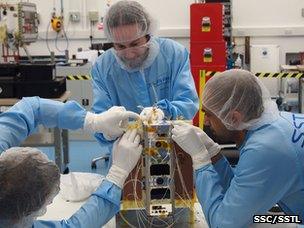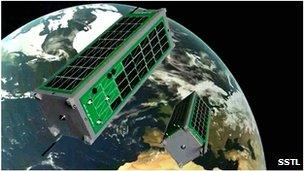Strand-1 'phone-sat' ready for orbit
- Published
- comments
Artist's rendition of the satellite in orbit and how the phone is fitted inside
The world's first "smartphone-sat" is ready for launch.
Known as Strand-1, the British-built spacecraft will be fully controlled by a Google Nexus device during part of its six-month mission in orbit.
The project has been led from the Surrey Space Centre (SSC, external) and Surrey Satellite Technology Limited (SSTL, external), both in Guildford.
Strand-1 was packed off to India this week for a rocket launch that is likely to occur at the end of the month.
The Nexus One, external has not been physically modified in anyway and will be an interesting test of everyday consumer electronics, says Dr Chris Bridges, SSC's lead engineer on the venture.
"We haven't gutted the Nexus. We've done lots and lots of tests on it; we've put our own software on it. But we've essentially got a regular phone, connected up the USB to it and put it in the satellite," he told BBC News.
"This is about looking at the latest technologies that are out there and seeing whether they are up to the harsh challenge of space."
Thrusting approach
The smartphone will fly pressed up against a side panel of the 30cm-long, 4.3kg "cubesat".
This will allow its 5-megapixel camera to look out through a hole and take pictures of the Earth and the Moon.
Strand is an acronym that stands for Surrey Training Research and Nanosatellite Demonstration, external. It is part of a quest to find new thinking and new technologies.

The finished Strand-1 was sent to India this week for a launch at the end of the month
SSTL, which is a world leader in the production of small commercial spacecraft, hopes some of the Strand lessons can filter through to its more traditional products.
For the first part of the mission, the satellite will be controlled by a new high-speed Linux-based cubesat computer developed at SSC, which is part of the University of Surrey.
An important goal during these early weeks will be to test two innovative propulsion systems.
One uses the ejection of a water-alcohol mixture to provide thrust. The system is tiny but has a grand name - Warp Drive, external (Water Alcohol Resisto-jet Propulsion De-orbit Re-entry Velocity Experiment).
The second propulsion technology on Strand is its pulsed plasma thrusters, external. These use an electric current to heat and ablate a material, producing a charged gas that can then be accelerated in one direction in a magnetic field to push the cubesat in the other direction.
Both propulsion systems produce only small amounts of thrust but are very efficient in terms of how much "propellant" they consume.
Scream App
Assuming the mission goes well, the team wants eventually, gradually to turn the operation of Strand-1 over to the Nexus.
Although phones, or parts of phones, have been sent into space before, running an entire satellite through such a device has not been tried previously.
The Strand Nexus also carries a number of "apps" for science and outreach, external.
One of them has garnered quite a bit of publicity already. This is the "Scream in Space" app suggested by Cambridge University students.
It will see the Nexus phone play videos of people screaming to test the famous Alien movie poster statement that "In space, no-one can hear you scream". A camera looking at the phone's own display will record the likely silent screaming faces in the videos.
This alternate camera will also show the satellite's telemetry rolling across the screen for another App, and there is a simple experiment also to sense the magnetic environment in space using the Nexus' own onboard magnetometer.
"It's not likely that we are going to pick up a smartphone, as is, and put it at the core of our $30m satellites," said SSTL's head of science, Doug Liddle.
"But what is likely is that we'll pick up the approach we've used. This could be some of the phone's components, such as its wi-fi chip or Arm processor; we might be able to re-use those.
"Consider also the Android Apps (open-source) approach to developing software - that might be something that could be transplanted into our way of doing things in the future.
"It would mean that instead of having a small, niche group of spacecraft flight-software developers, you could suddenly call on a global community of app developers to help you design control or telemetry-handling systems for spacecraft."
Kinect docking
Strand-1 is booked to fly on the Indian space agency's (Isro) Polar Satellite Launch Vehicle (PSLV) on 25 February.

Strand-2: Kinect will form the basis of an in-orbit proximity sensor and docking system
It is a piggyback passenger on the rocket. The main payload is a prestige Franco-Indian altimetry mission, Saral, which will measure sea-surface height. SSTL also has one of its larger platforms aboard called Sapphire, which will do space surveillance for the Canadians.
The Strand-1 cubesat will be pinged out from a spring-loaded pod mechanism at an altitude of 785km once the rocket's main business has been completed.
The terms of its UK Space Agency licence mean Strand must be brought out of the sky at the end of its mission in a timely fashion to avoid adding to the junk in orbit.
A Strand-2 is already in development. This will see two cubesats use the motion-sensing technology in Microsoft's XBox Kinect devices to locate each other in space and dock together.